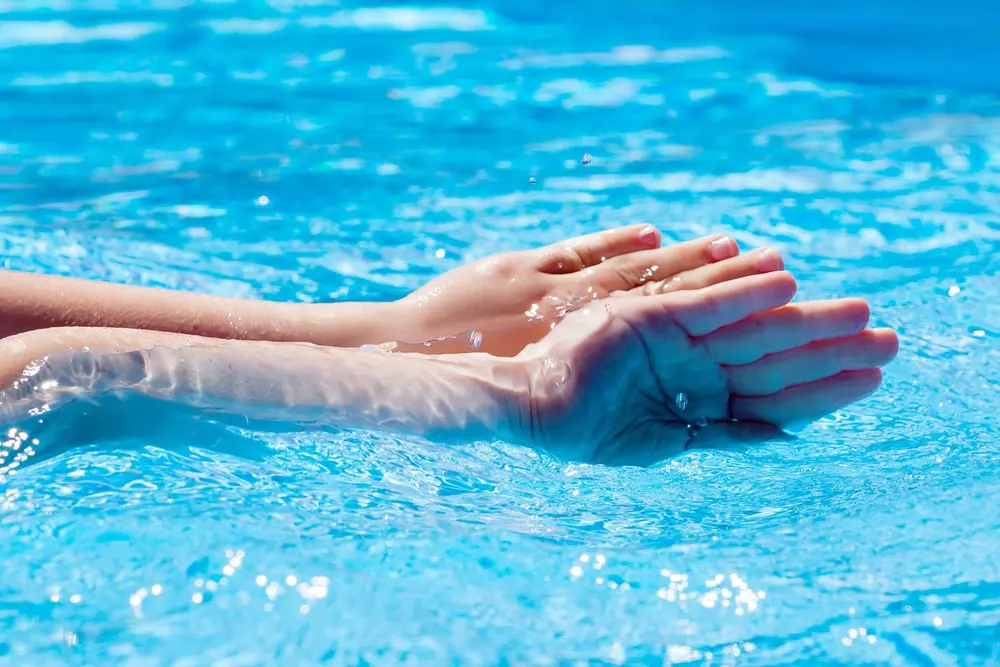Swimming pool operators obviously need to pay close attention to maintaining their facilities. However, a key aspect of swimming pool maintenance is the increased complexity of this, caused by the number of installations and accessories. This is why appropriate maintenance has to be holistic, looking after the entire installation and not overlooking any of the pool’s elements.
Swimming pool maintenance involves monitoring and acting on the water quality, filtration and recirculation, disinfection, cleaning of walls and floors, maintaining accessories, and looking after the humidity and temperature in any pool environment.
In this article, we’ll introduce each of these elements and the key information that pool operators need to know. This is crucial not just for adhering to local regulations and safety requirements, but also to create a safe, attractive, and pleasant space for swimmers and leisure bathers to come to.
Dive deeper with the eBook
Water pH levels
Pool water is clearly the most important element involved in any swimming pool maintenance. And it all starts with monitoring and adapting the pH level, i.e. the indicator of acidity or alkalinity of the water. This is a first and foremost indicator of a well balanced swimming pool.
The recommended pH range is between 7.2 and 7.8 . Maintaining your water between these parameters is essential because changes can lead to problems such as causing skin irritation, damage to pool equipment, green water, and cloudy water, among others.
The pH level can fluctuate due to factors such as rainfall, temperature changes, external debris entering the pool, swimmers’ use, drop-off of sunscreen lotions, etc. Therefore, regular testing of your pool water is essential to ensure that the pH level is within the recommended range.
It is easy to test the pH in a pool with a pH testing kit , which includes testing strips or a liquid reagent, a color chart, and instructions. However, the optimal way is to integrate an automatic pH controller (such as AP PR Series, Guardian Pool or Acqua Dos PH/ORP dosing pumps), which ensures that the pool is always in good conditions and avoids carrying out any manual tests.
Also, it’s important to test and control the pool’s alkalinity. This helps prevent sudden changes in the pH and ensure that chlorine is working effectively to keep water clean. Recommended levels are 100 – 150 ppm.
Water recirculation
Efficient and sustainable water recirculation leads to reusing the pool water and thus reducing consumption. This is done by collecting contaminated water which is filtered, disinfected, then returned to the pool.
Water recirculation also helps ensure that disinfectant agents and other products are evenly distributed in the water. It also eliminates so-called “dead spots” with stale water, ensuring the entire pool is fresh.
The time it takes for the whole water volume to move through the pool’s filtration system is called the turnover rate. There are specific rules and regulations in each country around the required turnover rate for commercial pools. This is an essential indicator of your facility’s ability to maintain water quality.
To ensure efficient and effective water recirculation, variable-speed pumps are the optimal choice. They adapt to the swimming pool’s real time needs and help to keep water fresh and safe for use.

Water filtration
Efficient filtration systems are also a cornerstone of swimming pool maintenance. A swimming pool operates at its best when it’s supported by the right filter size, an adequate filter media and when routine maintenance is performed properly, to ensure there is a reduced need to use chemicals for disinfection.
All filter media are made of granular materials, including sand, perlite, and glass. Located inside the filter, it’s where the debris gets trapped. They combine efficiency and low maintenance requirements.
For the filter, the key requirement is to have an appropriate size in relation to the size of the pool itself. Commercial pools should opt for glass-fibre reinforced plastic (GRP) filters, which are highly resistant to chemicals and mechanical wear and tear, enjoying a longer life.
Regardless of the type of filter, they will accumulate traces of lime, organic debris, and sediments over time — which stick to the filter media and begin to reduce their effectiveness. To avoid this, a series of maintenance activities should be carried out, including:
- Backwashing. This is a process that makes water currents flow upwards, aiming to sweep away any dirt particles that get trapped in the filter media and remove them. It’s advisable to do a backwash every two weeks, at least once a month, depending on the pool size and usage pattern, as well as your filtration system;
- Air scouring. As an alternative to backwashing, the process reduces water consumption and can clean filter media more efficiently. Air is injected through a special connection at the bottom of the filter or by the backwash water inlet. This process only consumes electricity, hence its superior efficiency;
- Changing filter media. Pool operators need to check the filter media routinely and to ensure that their bed depth is sufficient, expanding as expected during backwashing. As soon as it is needed, filter media should be changed for a better performance.
Regarding filter media, there are also regenerative filters which can be used to trap particles on the surface of flexible tubes coated with perlite. As soon as the perlite is saturated, the filter regenerates this media by vibration. With regenerative filters, you can achieve up to 50% energy savings and also reduce chemical use (saving circa 30%).
Finally, another way to enhance the effectiveness and efficiency of your water filtration systems is flocculation . This process expands the size of particles of debris, which makes them easier to trap by the pool’s water filters.
Water disinfection
Along with recirculating, filtering and treating the water by ensuring an optimal pH balance, another swimming pool maintenance activity is disinfecting it. This is the way to keep it safe and hygienic for general use. It’s also a way to prolong the life of accessories and pool components, protecting them from contamination, rust, etc.
Disinfection systems work by removing impurities and any potentially harmful substances from the water. They operate with chemicals, manually, or through the use of automated systems such as Heliox UV, Neolysis or Freepool2, by adding chlorine or salt to pool water in order to keep it free of contaminants.
Chlorine is the best known and most popular disinfectant chemical for pools. It helps remove algae, bacteria, and other elements from the water. Although its popularity has somewhat decreased since the introduction of saline chlorination systems that use salt for disinfection.
Salt is a far more natural and environmentally friendly way to disinfect pool water. Systems based on salt generate chlorine through electrolysis, a process that separates elements from any compound through electricity. Salt water is used to dissolve chlorine and instantly sanitise the pool water.
Additionally, some systems also feature ultraviolet technology within the salt electrolysis equipment, which enhances hygiene and saves on water consumption. Adding a medium-pressure UV lamp breaks down bacterial DNA as water passes over it — thus reducing the need to consume more chemicals for disinfection.
Pool cleaning
Swimming pool maintenance also includes cleaning the actual pool basin, that is, walls and bottom. For daily cleaning, automatic robot cleaners and manual pool vacuums sweep the basin quite effectively. For smaller, harder-to-reach sections, you will need to use dedicated products applied with manual brushes or high-pressure descalers at least twice a week.
If your pool features panels with PVC liners or gresite, cleaning is faster and easier since there are no joints or small hard-to-reach areas. If you encounter organic stains on these surfaces, the best products for cleaning PVC liners are so-called “magic erasers” and white clay stones.
In some countries, regulations require that larger swimming pools with lots of users be emptied completely once a year, to ensure the cleanliness of the water. This is also an opportunity for a deep cleaning of the basin.
Beyond the pool basin, several elements and accessories also need to be kept clean: ladders, handrails, the overflow channel, podiums, water jets, showers, lights, ornamental pieces, etc. All these need to be cleaned manually approximately two times a week with sponges and disinfecting products adapted to each material.
Finally, hydraulic systems and associated equipment help control the water quality, volume, and temperature of a pool. These also need to be checked and cleaned regularly to keep them working at their best.

Maintenance of stainless steel elements
Stainless steel pools and accessories benefit from higher hygiene levels automatically and require less maintenance and use of chemicals overall. Stainless steel can be cleaned easily through high-pressure jet washing containing specific disinfectant products.
To prevent rust or corrosion, stainless steel cleaning needs to take into account the following aspects:
- Ensure that water pH balance is maintained throughout the operating season;
- Use specially designed brushes that don’t scratch the steel;
- Avoid sandpaper, scourers, or harsh chemicals;
- Use a special polish followed by brightener to remove rust stains and calcium buildup;
- Always wipe off and remove accumulated dirt first, then wash with a neutral soap solution with tap water; rinse with clean water and dry with a cloth.
Stainless steel pools and accessories (stairs, railings, waterfall /rainfall shower installations, skimmers, water jets, filters, grills, lighting elements, etc.) need to be cleaned once a week at first. When not in use, it’s best to remove those accessories that can degrade, clean them, and store them away until the next bathing season.
Temperature and humidity levels
Using high-performance heat pumps and coolers, as well as thermal pool covers, will help to maintain an ideal temperature in your pool and extend the bathing season.
Heat pumps provide great levels of efficiency and significant energy savings. The most innovative models enable operators to save significantly, since up to 80% of the energy used to heat the pool comes from the air.
In pools that are not covered, water evaporates in a significant proportion. This can lead to loss of water, lower water temperatures, and excess humidity in the air. Covers are used to help avoid this phenomenon as much as possible. They are also a significant help in reducing water and energy consumption.
Moreover, excessively humid air can lead to mould, structural damage, corrosion, and faster deterioration, alongside an uncomfortable and unhealthy environment for pool users. In the case of high-humidity environments, you should use dehumidifiers to bring an indoor pool to the ideal range of 55-65%, in addition to disinfecting the air with an UV system.
Automatic remote control: Smart solutions for pool maintenance
It is always a significant constraint to have to be present on-site for attending swimming pool maintenance and cleaning, especially for those commercial pool operators with more than one pool under their supervision. This scenario also leads to higher costs and extra time, as well as resources being spent to ensure all is working properly in each pool.
Smart pool solutions enable operators to automate a large part of swimming pool maintenance work, while accessing all the key information from the pool’s indicators (humidity levels, water chemical balance, temperature, etc.). Through remote online access and scheduled activities, pool operators can manage the water filtration and recirculation, the disinfection system, the water levels, the temperature, the lighting, and even water features such as hydromassage jets. All this saves time, money, and human effort significantly.
Having a smart pool provides peace of mind, 24/7 water quality, savings, improved durability, and an extended lifecycle. It unifies all swimming pool maintenance activities under one console and will make you more efficient and sustainable at the same time.
